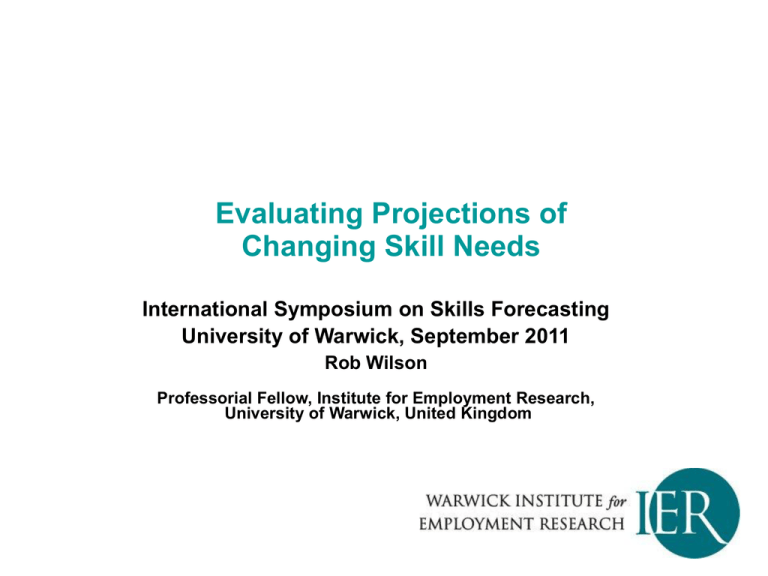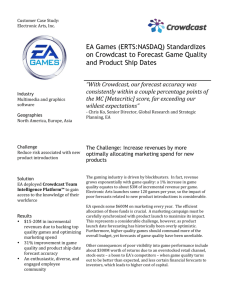Evaluating Projections of Changing Skill Needs International Symposium on Skills Forecasting
advertisement

Evaluating Projections of Changing Skill Needs International Symposium on Skills Forecasting University of Warwick, September 2011 Rob Wilson Professorial Fellow, Institute for Employment Research, University of Warwick, United Kingdom Overview General considerations Background - rationale for skills projections Quantitative metrics Causes of errors Alternative approaches to evaluating projections Quantitative evaluation of the results (internal/external); and Qualitative assessments (getting the message across; review of users opinions) Previous attempts to assess skills projections Some tentative conclusions General Considerations in Evaluating Labour Market Forecasts Accuracy, value and usefulness - Should we expect accuracy in labour market forecasting? Understanding the rationale for employment forecasting - What is the purpose of forecasts? Making technical information digestible for a lay audience To guide individual decisions and highlight alternatives Setting out options to policy makers To influence and change behaviour, including policy Therefore outcomes may be EXPECTED to be different from forecasts Need for a qualitative as well as quantitative assessment of employment forecasts Forecasts can: • • • • • Make assumptions about the Future Explicit & Transparent Help to Enforce Systematic and Logical Thinking Act as a Focus for intelligent Debate Provide a useful counterfactual to assess policy impacts Explain past developments in a coherent and logical fashion and then how this behaviour may develop into the future But they cannot deliver: • Mechanistic “manpower” plans • Precise indications of education and training requirements or job opportunities • Not a crystal ball: impossible to foresee the unforeseen Quantitative and qualitative assessment • Quantitative measures of forecast accuracy • Metrics, Losses and Scores Absolute (000s) and relative (%) errors Direction of change Significance / importance • Qualitative assessments of: accuracy usefulness Quantitative Metrics Absolute error = Zi − Ž i (may be positive or negative) Relative error = (Zi −Ž i) / Yi Zi represents the outcome for some particular quantity being projected ( e.g. Employment in a particular occupation and/or qualification category), Ž i represents the projected value and Yi indicates the level of employment in that category i. (by definition Zi = Yi for expansion demands) Mean absolute percentage error (Absolute value of Absolute error; weighted, MAPE(wt) and unweighted, MAPE) Direction of change (DoC) Rank by change (RbC Spearman rank correlation coefficients (absolute & percentage change) Dissimilarity Index (DI) (focuses on employment shares) Loss, Average Loss & Scores Loss: Li (Ž i) = ((Zi –Ž i) / Yi )2 Average loss: (AL) is determined by weighting the separate losses according to the size of the occupational or qualification category Forecasts should be compared to some plausible alternative forecast method not some unattainable ideal of "perfect accuracy" The most basic alternative is SAB: (Same as Before) which assumes no changes between the base and the forecast year – various other “naïve” alternatives can be used (past trends, etc) Score: the ratio between the predictive quality of the forecast (loss or average loss) and the predictive quality of some such alternative reference forecast (Score is smaller than 1 if the forecast is better than the reference forecast and is more than 1 if the forecast is inferior to the reference) Qualitative evaluation Qualitative evaluation of projections (illustrative) Outcome/ Forecast Fast Low Little decline decline change Low High all growth growth Fast decline Slow decline Little change Slow growth Fast growth Total 5 6 4 0 0 15 0 0 4 6 0 10 5 10 0 0 0 15 0 4 10 10 1 25 0 0 2 4 10 16 10 20 20 20 11 81 Explaining the Errors - Problems in measurement & possible source of data errors History Historical data revisions Changes in classification Error in the measurement of the dependent variable Errors in the endogenous drivers and Forecasts Errors of judgement about exogenous variables; Errors of specification, reflected in the various parameters of the model; Errors of judgement in running the models Distinction between Scale (macro), Sectoral & Occupational effects Previous and recent attempts to assess skills forecasts US BLS projections (Bishop et al, Rosenthal and most recently Wyatt) Dutch experiences (ROA, Borghans and deGrip, Dupuy) Australia (Meagher et al) UK (Wilson, Wilson et al) Pan- European / Cedefop (Kriechel, Pollitt and Wilson) Assessments of US Projections • Broadly correct, but errors in detail • Industries BLS does better than the naïve models in all metrics: DoC MAPE & MAPE(wt) DI RbC (both Spearman RCCs) • Occupations BLS does better than the naïve models in 3 of 4 metrics: DI MAPE & MAPE(wt) • Generally better at projecting larger occupations Summary of UK experience • Broadly correct, but errors in detail • Industries Margins of error similar to average changes in the variables Much of the error attributable to revisions to historical data or to shifts in exogenous factors • Occupations Margins of error slightly less than average changes in the variables (but uses a higher level of aggregation than BLS) Replacement demands smaller % errors The Dutch experience • Covers Qualifications as well as Occupations, Demand and Supply • Broadly correct in qualitative terms • Replacement demands better “Loss” than for Expansion demands • Generally average Loss and Scores improving over time • Changes in industry classification caused considerable problems recently • But many Scores in excess of unity especially for Replacement Demands suggests further room for model improvements Cedefop projections • Evaluation a key component of the project • Quantitative and qualitative aspects • Qualitative: Report on survey held among SkillsNet members and AGORA 2009 & 2010 visitors Response (n=65); Of which (n=48 “experts”) Topics include: Use of results Evaluation of outcomes Assessing the Cedefop Pilot projections – Quantitative results Very early days, pilot projects only undertaken in 2008 and very short times series (projections made only shortly before the GFC) By far the largest difference in both actual outcomes, due to the economic crisis Makes any short-term assessment difficult - for example, productivity changes in 2008-09 would have been impossible to predict But apart from levels, other trends not so dramatically affected (some errors by industry, less significant by occupation and qualification) Qualitative evaluation – General approach Usage and Usability of CEDEFOP Forecasting Model Qualitative Evaluation: Focus groups Qualitative evaluation: Internet Survey Instrument Qualitative Evaluation -Topics I. Usability i. ii. iii. II. Workbooks Actual usage Interactive Outcomes i. ii. iii. iv. v. Sector Occupation Education Supply / Demand Level of aggregation III. Methodology i. ii. iii. iv. v. Sector model Scenarios Expansion demand Replacement demand Supply (stock / flow) Comparison of overall Cedefop results to national forecasts Percent Don't know Very close to national forecast / expectations 10,87 6,52 Same direction of outcomes 50,00 Partially contradicting outcomes 30,43 Contradicts national forecasts / expectations n 2,17 46 Importance of different aspects of the Cedefop forecasts 0% 10% 20% 30% 40% 50% 60% 70% 80% 90% 100% forecast on number of workers in sectors forecast on demand for workers in occupations forecast on demand for workers by education level forecast on labour supply by education forecast on imbalances (1) very important (2) important (3) neutral (4) less important (5) unimportant national Supply of skills Demand by qualification Replacement demand Demand by occupation Demand by Sector Plausibility of Cedefop forecasts cross-country 1 plausible 2 partly plausible 3 neutral 4 partly plausible implausible 5 Value added of Cedefop forecast relative to national forecasts 22.2 0% 10% 33.3 20% 30% (1) very much value added (4) not much value added 40% 31.5 50% 60% (2) much value added (5) no value added 70% 9.3 80% 90% (3) some value added 3.7 100% Value of Workbooks Able to change underlying data Detailed data in workbooks (1) very important 19,57 52,17 (2) important 47,83 39,13 (3) neutral 21,74 4,35 2,17 4,35 8,7 0 (4) less important (5) not important Observations 46 Some tentative conclusions • Nobody has a crystal ball - art as much as a science • Forecasts may be better to be wrong! • Projections not inevitable, the future is not predetermined may be able to take actions to improve things • Skills forecasts should be compared with viable alternatives & generally add value to naïve alternatives • Historical data revisions are a key source of error, as are political and other exogenous events • Forecasts are useful and broadly accurate • Sectoral focus is key • Methods improving, errors no worse than in other forecasts • It is important to develop better, more detailed, data, Europe still has some way to go Contact Details Rob Wilson Institute for Employment Research University of Warwick COVENTRY, CV4 7AL r.a.wilson@warwick.ac.uk Tel:+(44) 2476-523530






